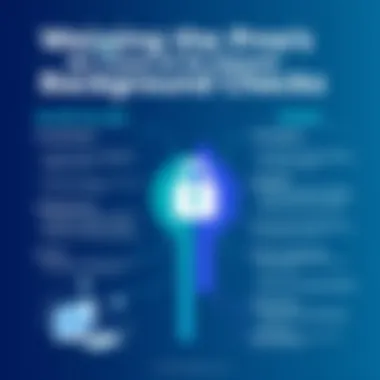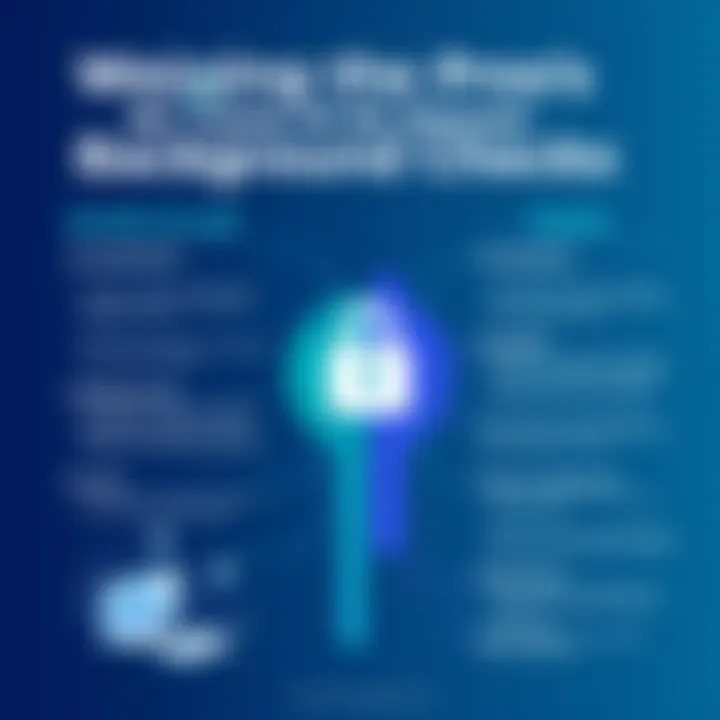AI Background Checks: Revolutionizing Employment Verification


Intro
In today’s fast-paced, technology-driven world, the realm of employment verification is undergoing a significant transformation. Traditional background checks are often perceived as cumbersome, slow, and prone to human error. This scenario is altering rapidly, thanks to the increasing integration of artificial intelligence. Employers are now leaning towards AI-driven solutions that not only enhance the accuracy of background checks but also streamline the entire verification process.
But what does this mean in practical terms? For businesses, the move towards AI can result in faster hiring processes, reduced costs, and improved safety and compliance. Job seekers, on the other hand, benefit from a more thorough approach that can help eliminate biases and enhance transparency in hiring decisions. However, it’s crucial to understand both the opportunities and the challenges posed by these innovations.
As we navigate through this article, we will dissect the intricacies of AI background checks. We will touch on the importance of these enhancements in today's employment landscape, current trends, and the methodologies underpinning data-driven analysis. In doing so, we aim to provide a comprehensive overview that equips tech-savvy professionals with the insights they need to navigate this evolving landscape.
Prelude to AI Background Checks
In the rapidly evolving world of hiring practices, AI background checks have emerged as a critical point of discussion. With the increasing demand for efficient processes and accurate assessments, organizations must adapt to the technological tools available. AI background checks blend the nuances of human resource management with the precision of advanced algorithms, transforming how employers verify the credentials of potential hires.
This section aims to dive into the essentials of AI background checks, unraveling their significance in the contemporary employment landscape. The integration of AI technologies not only streamlines the verification process but also enhances its reliability. As businesses face the challenge of combing through numerous applicants, the importance of adopting AI-driven checks cannot be overstated. It’s like having a finely tuned compass in an ever-changing maze of talent acquisition.
Defining AI Background Checks
AI background checks refer to utilizing artificial intelligence to streamline the process of verifying an individual’s credentials, work history, criminal background, and other essential information. Unlike traditional checks that often rely on manual labor and prolonged waiting periods, AI background checks leverage massive datasets and machine learning algorithms to produce quicker and often more detailed results.
To illustrate, consider an organization seeking to hire a data analyst. Instead of sifting through countless resumes and calling references, an AI system can instantly compare the applicant's history against a vast database. The AI can analyze trends and correlations that humans might overlook, ultimately ensuring the best candidate is chosen based on a holistic view of their background.
Significance in Today's Employment Landscape
The relevance of AI background checks in today’s employment landscape is profound. Given the rising number of job applicants and the complexity of credentials, the sophistication of AI tools adds significant value. These tools help businesses save valuable time while enhancing security measures, ensuring they onboard trustworthy personnel.
- Efficiency: The speed at which AI performs checks cannot be matched by manual processes. Employers enjoy quicker hiring timelines, allowing them to secure top talent before competitors do.
- Comprehensiveness: AI can analyze various data points—from social media activity to professional networks—providing insights that are often neglected in conventional methods.
- Reduced Bias: When developed and implemented correctly, AI can help mitigate unconscious bias in hiring decisions, offering a more equitable hiring process.
"The use of AI in employment verification represents a transformation that combines efficiency with depth, appealing to recruiters' desire for thoroughness and speed."
In summary, AI background checks symbolize a shift towards data-driven recruiting. This transition marks a new chapter in employment verification, balancing exploration of candidates' backgrounds with an unwavering emphasis on efficiency and accuracy. As we delve deeper into the mechanics, advantages, and challenges of these checks, it becomes clear how pivotal they are in shaping the future of employment practices.
History of Background Checking
Understanding the history of background checking is essential to appreciate the current transformation in employment verification processes due to artificial intelligence. Essentially, it serves as a foundation that highlights how far we’ve come in assessing the qualifications and integrity of potential employees. Background checks were once rudimentary processes, often relying heavily on personal references and word of mouth. These methods could be hit or miss, ultimately leaving employers with incomplete or inaccurate information about candidates. The evolution from these traditional practices to today’s AI-driven checks illustrates the growing need for accuracy, efficiency, and trustworthiness in hiring decisions.
Traditional Background Checks Methodologies
In the past, background checks were primarily executed with simple, manual processes. Employers would often ask applicants to provide references, usually friends or past supervisors, who would vouch for their character. While this method might have worked for small businesses or close-knit communities, it often fell short on several fronts:
- Subjectivity: The evaluations were inherently biased. A reference might only speak positively about a candidate, leading to an incomplete picture.
- Limited Reach: Background checks focused mostly on the applicant's immediate circle rather than comprehensive investigations.
- Time-Consuming: The need for verbal confirmation could stretch for weeks, delaying the hiring process.
Additionally, criminal record checks used to be primarily reliant on paper records, adding yet another layer of inefficiency.
Emergence of Technology in Background Verification
The introduction of technology marked a pivotal turning point in the background checking landscape. With the dawn of the digital age, employers could access online databases that contained criminal records, credit reports, and employment histories from multiple sources within minutes rather than weeks. This shift opened the floodgates for:
- Increased Speed: Decisions in the hiring process could be made swiftly; what once took time, now only required a few clicks.
- Integration of Data Sources: Various databases could be tapped into, providing a more comprehensive view of the candidate’s background.
- Standardization of Processes: Employers could develop consistent protocols, helping to mitigate biases present in traditional methodologies.
However, this technological uplift was not without its drawbacks. Questions surrounding data privacy, consent, and the accuracy of digital records began to rise, laying the groundwork for today's debates on ethical implications in AI-driven background checks. The move toward integrating AI into background screenings suggests a further transformation that addresses these challenges while aiming for more reliable results.


"The history of background checking not only illustrates a leap in technology but also reflects evolving societal expectations in hiring fair and qualified individuals."
When considering how to employ AI in background checks, reflecting on this historical journey helps frame ongoing discussions regarding improvements, challenges, and necessary regulations that could influence the future of employment verification.
Mechanics of AI in Background Checks
The mechanics of AI in background checks is pivotal, shaping how businesses verify candidates. With the reliance on technology in our professional lives, understanding this element becomes crucial. AI is not just a tool; it's a powerhouse that streamlines operations while enhancing accuracy. Businesses aiming to maintain a competitive edge need to grasp the intricacies of how AI works in this context.
Data Collection Techniques
In the world of AI-powered background checks, data collection techniques form the backbone of the entire process. Collecting relevant information in a systematic way allows organizations to build a comprehensive profile of potential hires. Various methods, such as web scraping, API data retrieval, and database accessing, can gather information from public records, social media, and other online entities.
Utilizing these techniques means having access to a wealth of data with just a few clicks or taps. The collection process often employs advanced algorithms that can extract and sort through multiple data points quickly, offering employers a clearer picture of candidates.
One common method used is natural language processing (NLP). This allows AI systems to read through text-heavy data, such as resumes or online portfolios, and identify relevant keywords that might indicate a match for the job requirements. Moreover, AI can scrape numerous platforms at once, from LinkedIn to professional websites, enabling a harvest of intricate details such as employment history, educational background, and even personal attributes.
For instance, when an applicant's LinkedIn profile contains endorsements for certain skills, AI can correlate these endorsements with the requirements of the job to ascertain a candidate's fit.
Algorithms for Risk Assessment
Once data is collected, the next step involves analyzing it. Here, algorithms play a crucial role in risk assessment. These algorithms are designed to sift through voluminous data, weighing factors like employment gaps, past infractions, financial history, and even social media activity in order to come to a conclusion about a candidate's reliability and integrity.
Various approaches can be implemented, from regression analysis to machine learning models that adjust based on new data inputs. This flexibility is what makes AI algorithms particularly potent; they are not static but evolve with each new dataset they are exposed to.
However, it's essential to regard the ethical considerations during this phase. For example, employing biased algorithms, whether inadvertently or intentionally, can lead to discriminatory practices. Businesses must ensure that the assessment criteria are transparent and just.
"Advanced algorithms can assess risk factors, but they must be equitable and free from bias to ensure that everyone is given a fair shot."
Automating Background Check Processes
The automation of background check processes is another compelling advantage of integrating AI. Traditionally, employment verification often involved significant manual effort, which can lead to errors or delays. With AI, this laborious task is streamlined, freeing up human resources for more strategic roles.
Automation expedites the evaluation process from days to mere hours. Employers can set parameters and allow AI to run with the task, receiving timely reports that highlight key findings. This level of efficiency not only enhances speed but also consistency in evaluations. Moreover, automated processes can work around the clock, ensuring uninterrupted service.
However, companies must balance automation with responsibility. It is prudent to incorporate a human-in-the-loop model where decisions triggered by AI analyses are reviewed by professionals, especially in high-stakes scenarios. Doing so can ensure that while efficiency is maximized, the qualitative aspects of candidate assessments remain robust.
In summary, understanding the mechanics of AI in background checks reveals a landscape of opportunity and caution. Tailoring data collection techniques and risk assessment algorithms ensures comprehensive evaluations, while automation presents significant efficiency gains. As organizations ride this wave of change, navigating the intricacies will be vital for responsible and effective employment verification.
Advantages of AI Background Checks
In a swiftly evolving employment landscape, leveraging artificial intelligence for background checks has become increasingly vital. The advantages that AI brings to the table can greatly impact both prospective employees and hiring organizations. By integrating AI into background verification processes, employers can transform their hiring practices, making them more efficient, accurate, and scalable.
Efficiency and Speed in Assessments
AI background checks streamline the verification process significantly. Traditional methods often involve labor-intensive manual reviews that can take days, if not weeks. In contrast, AI-driven systems can comb through vast data sets almost instantaneously. This capability minimizes the time taken for background checks from days to just a few hours. With algorithms programmed to sift through criminal records, employment histories, and educational credentials, employers can make informed hiring decisions more rapidly.
Moreover, the automation of repetitive tasks allows human resources professionals to focus on more nuanced aspects of the hiring process, such as candidate engagement and cultural fit. As the saying goes, "Time is money"—faster processes can lead to quicker placements, ultimately reducing costs for organizations.
Enhanced Accuracy and Reduction of Human Error
When it comes to decision-making in hiring, accuracy is paramount. Human error can lead to significant consequences, including costly mis-hires or legal issues stemming from incorrect background checks. AI systems are designed to analyze data without the biases that sometimes cloud human judgment. This inherent objectivity drastically reduces the possibility of errors due to oversight or misinterpretation of information.
Additionally, AI technology continuously learns and improves from the data it processes. Algorithms can adapt and refine their criteria based on feedback or changes in law and regulations, ensuring that the checks remain current and relevant. Employers stand to gain from this enhanced accuracy—higher confidence in candidate assessments leads to better hiring decisions.
Scalability for Large Enterprises


One of the standout benefits of AI background checks is scalability, particularly crucial for large corporations managing extensive hiring drives. As businesses grow or temporary workforce needs fluctuate, the ability to process a high volume of background checks becomes essential. AI solutions can handle this seamlessly, adjusting to the needs of the organization without sacrificing quality or efficiency.
For instance, a megacorp in the retail sector may need to onboard thousands of seasonal workers in a matter of weeks. Traditional methods would be ill-equipped to meet such demand, leading to delays and potential losses in revenue. With an AI-driven background check system, these businesses can process applications en masse while maintaining a high standard of accuracy. This scalability ensures that companies are not just filling positions quickly, but also responsibly vetting talent to uphold their brand integrity.
"In today's competitive job market, adopting AI for background checks isn't just a benefit; it's a necessity."
Challenges Facing AI Background Checks
As we delve into the intricacies of AI background checks, it becomes clear that while technology presents numerous benefits, it does not come without its hurdles. Addressing these challenges is essential for maintaining trust in the employment verification process and ensuring fair treatment for all job candidates. Understanding the specific elements surrounding these obstacles provides a comprehensive view of the landscape where AI and employment verification intersect.
Data Privacy and Security Concerns
In a world driven by data, the prime concern for businesses and individuals alike is how personal information is collected, stored, and utilized. With AI background checks, the sheer volume of data processed raises red flags regarding privacy. The integration of AI necessitates that organizations prioritize stringent security measures to protect sensitive data from unauthorized access.
Why It Matters: The implications of inadequate protection can be far-reaching, potentially leading not only to data breaches but also to significant reputational damage for businesses involved. Additionally, stricter regulations, like the General Data Protection Regulation (GDPR) in Europe, require a proactive approach to ensure compliance.
Organizations must be aware of the types of data they are processing. For example, even seemingly innocuous information, like social media accounts or online interactions, can paint a vivid picture of an individual’s life. If mishandled, this can lead to a breach of trust between employers and potential employees. Therefore, embedding robust privacy policies into AI background check procedures is essential. Regular audits along with transparency in data handling can serve as a foundation for building that trust.
Potential for Bias in AI Algorithms
One of the fundamental attributes of effective hiring practices is fairness. However, as AI systems learn from pre-existing datasets, they may inadvertently perpetuate biases present in that data. If companies do not tread carefully, they could find themselves entangled in controversies regarding discrimination.
The Weight of Data: It's crucial to recognize that if past hiring practices favored certain demographics, the AI might lean towards similar patterns. This is a slippery slope where the objective of enhancing fairness in hiring could backfire. For instance, a system trained primarily on data from predominantly male candidates may undervalue applications from women or minority candidates simply because of skewed historical data.
To combat this, organizations should actively seek to identify biases in their AI training data. Incorporating diverse data sets and enlisting professional audits can help mitigate the risk. Continuous testing of AI systems will allow for adjustments that promote equity, ensuring every candidate is evaluated based on merit rather than ingrained biases.
Legal and Ethical Implications
Employers utilizing AI in background checks must navigate a complex landscape of legal and ethical considerations. The legal framework surrounding employment verification is evolving, and organizations must stay ahead of the curve to avoid potential pitfalls.
Understanding Liability: One critical aspect involves understanding which entities are liable in case of errors or misrepresentations made by AI systems. If an AI-driven check misclassifies a candidate or incorrectly flags a report, whose responsibility is it? Companies must be diligent in understanding the risks as well as the liabilities associated with their AI tools.
Moreover, ethical considerations go beyond legal compliance. Organizations should strive to create fair systems that respect human dignity and individual rights. Transparency around how AI-derived decisions are made, alongside informing candidates about data usage, signifies a commitment to ethical practices.
As businesses incorporate these technologies, it is vital that the implications of such choices are thoroughly examined to uphold both ethical and legal standards.
Integrating AI Background Check Systems
Integrating AI background check systems has become a pivotal aspect of modern business practices. As companies increasingly rely on technology to enhance their hiring processes, understanding the specific elements that contribute to a successful integration is essential. From selecting the right tools to ensuring compliance with regulations, each factor plays a significant role in shaping an organization’s approach to background checks. This section delves into the steps necessary for effective integration, focusing on the advantages and considerations involved.
Selecting Appropriate AI Tools
Choosing the right AI tools for background checks is akin to picking the right fish in a sea of options. Not every tool is a fit for every organization, and businesses need to take into account their specific needs when making this selection. Factors to consider include the size of the company, the volume of checks required, and the type of data necessary for assessments. Companies might opt for comprehensive solutions like Checkr or GoodHire, which not only provide verification services but also ensure compliance.
On the flip side, some businesses may benefit from specific tools that target niche areas like criminal record checks or employment history verification. It’s crucial to evaluate the features, user interface, and customer support offered by the providers. Failure to do proper research can lead to potential pitfalls down the line, affecting the overall integrity of the hiring process.
Training Staff on New Technologies
Integration isn’t just about tech—people need to be trained as well. Staff training on new technologies ensures that the tools implemented are used effectively. Employees must understand not just how to operate these tools, but also the underlying principles of data accuracy and compliance. This means hosting workshops or training sessions that focus on the why of AI background checks, not just the how.


Key areas to cover in training:
- Understanding AI Algorithms: A basic grasp of how algorithms assess risks and make determinations can empower staff to better interpret the results.
- Data Privacy Importance: Highlighting the significance of protecting sensitive information can contribute to a culture of compliance and responsibility.
- Interpreting Results: Employees should learn how to analyze outcomes effectively, distinguishing relevant findings from noise.
Ensuring Compliance with Regulations
The regulatory landscape surrounding background checks is both intricate and essential for maintaining an ethical hiring process. Organizations must ensure that their AI systems comply with both local and federal laws, such as the Fair Credit Reporting Act (FCRA).
"Compliance is not just a checkbox; it's a safeguard for your business against legal repercussions."
Regular audits of AI tools, keeping abreast of regulatory changes, and possibly consulting with legal experts can aid in navigating this complex terrain. Furthermore, transparent communication regarding data usage with candidates is integral. Companies should inform applicants of their rights and how the data from background checks is utilized in the hiring process. Failure to comply with regulations not only poses ethical dilemmas but can also have serious legal ramifications.
Integrating AI background check systems is not an overnight task but rather a calculated strategy that has the potential to significantly enhance hiring procedures. By carefully selecting appropriate tools, training staff adequately, and ensuring compliance, companies can position themselves ahead of the curve in the dynamic employment landscape.
Future Trends in AI Background Checking
The landscape of AI background checking is constantly evolving, reflecting broader technological changes and shifting expectations for employment verification methods. As AI continues to reshape several domains in industries, its influence on background checks cannot be understated. Organizations need to stay ahead of the curve by understanding key trends that will shape the future of these processes. By exploring emerging technologies and their potential impacts, businesses can ensure they are not lagging behind in the pursuit of efficiency, accuracy, and compliance.
Emerging Technologies to Watch
As we look at the horizon of AI background checking, several technologies stand out, poised to revolutionize the methodology of how we validate a candidate’s past. These include:
- Machine Learning Enhancements: With algorithms becoming progressively better at pattern recognition, employers can expect more nuanced insights into potential hires. Machine learning can analyze vast datasets to provide indicators of reliability and performance that go beyond traditional metrics.
- Natural Language Processing (NLP): This technology can be incredibly useful for analyzing written documentation and online presence, helping verify if a candidate’s statements align with what’s available publicly. NLP can categorize unstructured data and highlight discrepancies in resumes or past job descriptions.
- Blockchain Technology: The transparent and secure nature of blockchain could enable verified records that remain tamper-proof. This makes it easier to confirm an applicant's credentials, reducing the hassle of background checks linked to past employment or education.
- Social Media Analytics: As professionals increasingly use social media platforms to represent themselves, companies are looking to analyze this digital footprint. AI-driven analytics tools can gauge a candidate’s social presence, providing insights into their character and interpersonal skills based on interactions and network behaviors.
By integrating these technologies into the background checking process, organizations can enhance their ability to sift through information rapidly while minimizing the risk of inaccuracies or outdated information.
Projected Impacts on Employment Practices
The integration of AI innovations in background checking is not merely about efficiency; it brings profound shifts in employment practices. Here’s how:
- Faster Hiring Processes: AI rapidly analyzes data compared to human capabilities, leading to shorter hiring cycles. Companies can make decisions based on robust insights without draining extensive resources.
- Fairness and Inclusivity Concerns: As AI tools evolve, there’s pressure on organizations to ensure these systems don’t propagate biases. Future systems are likely designed with fairness at the forefront, focusing on reducing discrimination based on race or gender while still maintaining reliability.
- Consistent Compliance Standards: With continuously changing regulations surrounding personal data usage, AI can keep track of relevant laws and industry standards, aiding organizations in adhering to specific compliance measures more effectively than traditional methods.
"With technology advancing rapidly, staying informed about these future trends is crucial. Businesses need to adapt to remain competitive in the labor market."
- Enhanced Candidate Experience: As the friction in hiring processes decreases, candidates may benefit from more transparent and swift feedback. This could lead to a better perception of the company, enhancing employer branding.
In summary, the future of AI background checking is bright and filled with opportunities. Organizations can enhance efficiency, maintain fairness, and streamline compliance through these emerging technologies. Companies that grasp these trends today will not only improve their background checking processes but also strengthen their overall hiring strategy.
Finale
In wrapping up our discussion on AI background checks, it’s vital to recognize the profound impact these systems hold in today’s employment arena. Not only have they streamlined the verification process, but they’ve also created new standards of accuracy and efficiency that traditional methods could hardly achieve. The conclusion here is not just an end, but a stepping stone for understanding the ongoing transformation in employment verification through AI.
Summary of Key Insights
AI background checks represent a leap forward in terms of how organizations evaluate potential hires. Here are some crucial points to consider:
- Efficiency: AI dramatically reduces the time taken for background checks. Where traditional methods might take days or weeks, algorithms can compile and analyze data within minutes.
- Accuracy: By utilizing vast data points and sophisticated algorithms, AI systems are better at minimizing human errors, leading to more reliable results.
- Data Security: Given the rise of data privacy concerns, AI systems incorporate advanced encryption methods to safeguard sensitive information. This adds required trust to the process for both employees and employers.
- Bias Awareness: With the potential for algorithms to embody biases, it becomes imperative for developers and companies to actively monitor their tools, ensuring that assessments remain fair and equitable.
This summary encapsulates both the opportunities and challenges associated with AI-driven background checks, emphasizing the need for businesses to navigate this landscape thoughtfully.
Call to Action for Stakeholders
For both employers and industry leaders, embracing AI in background checks calls for a proactive approach. Here’s why involvement and awareness are crucial:
- Stay Informed: Continuous learning about AI developments can empower businesses to stay ahead. Encourage workshops around emerging trends.
- Evaluate Tools: Conduct regular assessments of the AI tools in use. Are they yielding the expected benefits? Are biases being monitored?
- Engage with Regulators: Keeping abreast of current regulations regarding data protection will prevent any legal hiccups down the line. Collaboration with advocacy groups can further foster a favorable landscape for ethical AI usage.
- Focus on Ethics: The rise of AI in background checks necessitates adopting ethical considerations. Commit to transparency in how data is handled and utilized, fostering trust between employers and candidates.
By actively participating in this dialogue and adopting a strategic mindset, professionals can effectively harness the power of AI background checks and contribute to a more reliable employment verification process. As the landscape continues to evolve, the importance of these elements cannot be overstated.







